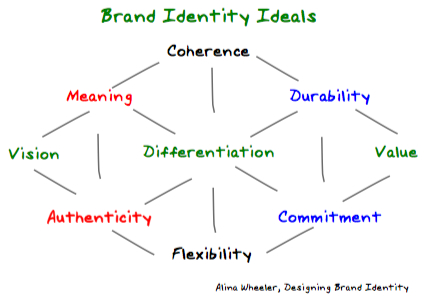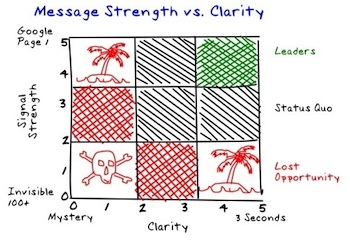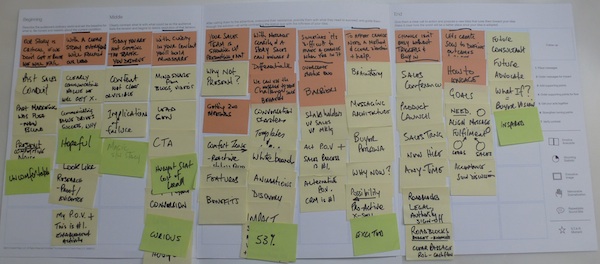How important is clarity in your messaging and how clear is your message?
I'd say it's the difference between life and death for start-ups.
Sales and marketing are dependent on the clarity of your message to win mindshare, generate leads; and to engage, diagnose and qualify new opportunities, yet clarity is often an afterthought.
I was prompted to write this article after a call this week with a technology company based in the Mid-West. This company has World leading technology, great vision and is completely failing in marketing.
They are in the red zone. When you arrive on their Website it is not possible to figure out that they do on the home page. Nor is it possible to figure out what they do by clicking on the CTA. You have to click on the product page to find the description of what they do and it's in 10 point font in the middle of the first paragraph. This is not a joke....this is a disaster.
Why Invest in Message Clarity?
Clarity attracts visitors, clarity engages visitors, clarity converts visitors into leads, clarity differentiates, clarity is monetizable, clarity wins new customers, clarity attracts employees, clarity builds mindshare, clarity wins investors, clarity builds market-share. You will see an new and clearer Admarco.net Website in the near future in pursuit of our own message clarity.
How do you measure the effectiveness or signal quality of your message for
Inbound Marketing purposes?
For radio operators in the military
and other organizations, the signal quality is reported on two scales; the first is for signal strength, and the second for signal clarity. Both these scales range from one to five, where one is the worst and five is the best. The listening station reports these numbers separated with the word "by". "Five by five" therefore means a signal that has excellent strength and perfect clarity — the most understandable signal possible.
This is a good metaphor to explore how well you are communicating over the Internet.
A Guide to the colors
I propose the following as a basis for discussion on the effectiveness of your messaging for Inbound Marketing purposes.
Green Zone: The leaders in dark green have invested and continue to invest in messaging excellence as a primary driver of their business.
Light Green: The Challengers believe in messaging and are working towards excellence.
Black: The status-quo need help with their messaging, but for one reason or another, it doesn't get done. It's not terrible and it's not great, the sales guys will have to make more calls.
Orange: Weak messaging is costing your business. You will fail over time and will be overtaken by your competitors unless you institute a program to improve your Google rankings and update your messaging urgently. You get no inbound leads and are dependent on trade-shows, word of mouth and cold-calling for lead generation
Red: This is the land of lost opportunity. It doesn't matter how good your products and services are, if buyers can't find you and your message is opaque, you are headed for failure...soon. Urgent action must be taken in the short term.
Desert Islands: It is highly unlikey that a company will have a crystal clear message and be invisible on Google. Similalry it is highly unlikely that a company will have excellent Google rankings and have a completely unintelligble message....but there may be a few out there on desert islands.
Dead Zone: Self explanatory
Signal Strength = Google Ranking for primary keywords.
5 = You rank on Google Page 1 for more than 20 primary keywords
4 = You rank on Google Page 1 for more than 5 primary keywords
3 = You rank on the first 3 pages for more than 5 primary keywords, but not P1
2 = You rank on the first 10 pages of Google for more than 5 primary keywords, but not on first three pages
1 = You are practically invisible on Google and only 1 primary keyword appears on first 10 pages, but not on first 3 pages
0 = No matter how hard I try I can't find your site through any keyword combinations on google - you are invisible
Messaging clarity = What is it you do and why should I bother?
When someone arrives on a Website with a clear message, they should be able to figure out what you do in the first 3-7 seconds while they make their decision to stay and explore more or leave.
Therefore I propose the following five point scale
5 = I get what it is you do and what it will do for me in 3-7 seconds.
4 = I get what it is in 3-7 seconds, but it takes me 10-15 seconds to figure out what it will do for me
3 = It takes me 10-20 seconds to figure out what it is and what it will do for me
2 = I can't figure out what it is, but I click on a CTA and it becomes clear what it it and what it will do
1 = I can't figure out what it is, I click on a CTA and I still can't figure out what it is, but I try the product page and there it is buried in 10 point font in the first paragraph.
0 = I can't figure out what it is or what it does, it's all gobbledegook
If you are in the red, orange or black, we can help.















